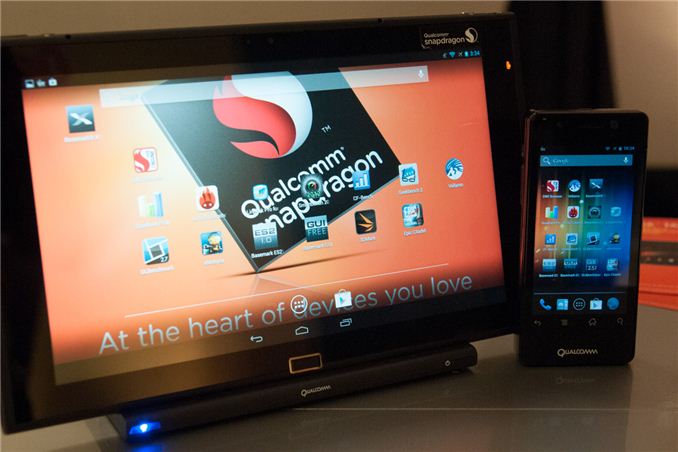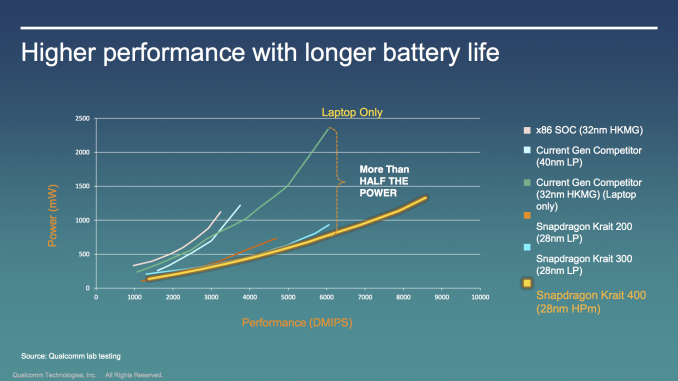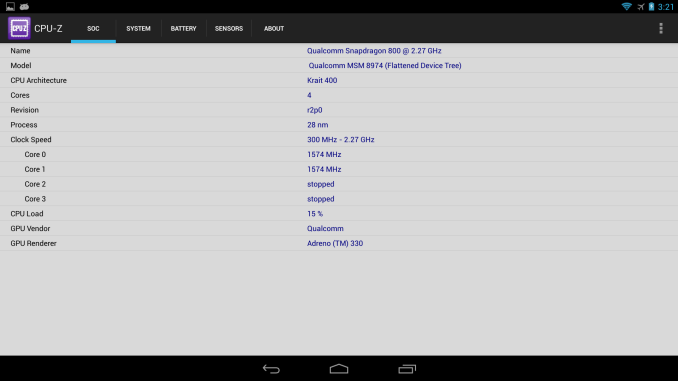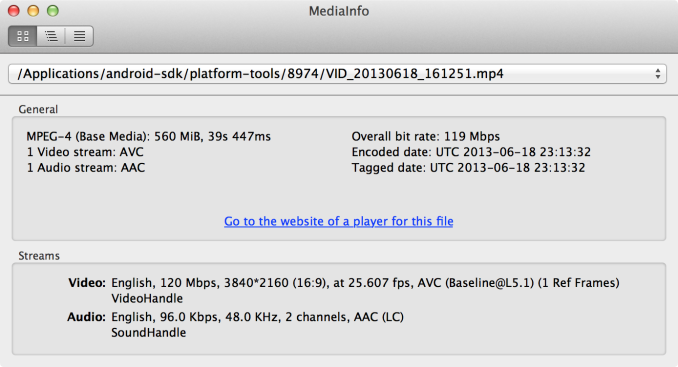Snapdragon 800 (MSM8974) Performance Preview: Qualcomm Mobile Development Tablet Tested
by Brian Klug on June 18, 2013 8:00 PM EST
We’ve written about Snapdragon 800 (MSM8974) before, for those unfamiliar, this is Qualcomm’s new flagship SoC with four Krait 400 CPUs at up to 2.3 GHz, Adreno 330 graphics, and the latest modem IP block with Category 4 LTE. Qualcomm is finally ready to show off MSM8974 performance on final silicon and board support software, and invited us and a few other publications out to San Francisco for a day of benchmarking and poking around. We looked at MSM8974 on both the familiar MSM8974 MDP/T, a development tablet used both by Qualcomm and 3rd parties to develop drivers and platform support, and the MSM8974 MDP phone, both of which have been publicly announced for some time now.
The tablet MDP is what you’d expect, an engineering platform designed for Qualcomm and other third parties to use while developing software support for features. Subjectively it’s thinner and more svelte than the APQ8064 MDP/T we saw last year, but as always OEMs will have the final control over industrial design and what features they choose to expose. Display is 1080p on the tablet and 720p on the phone, a bit low considering the resolutions handset and tablet markers are going for (at least 1080p on phone and WQXGA on tablets) so keep that in mind when looking at on-screen results from benchmarks.
| Qualcomm Snapdragon 800 Mobile Development Platform Tablet | |
| MSM8974 MDP/T | |
| SoC | MSM8974 Snapdragon 800 |
| CPU | 4x Krait 400 at 2.3 GHz |
| GPU | Adreno 330 at 450 MHz |
| RAM | 2GB 2x32 LPDDR3 800 MHz |
| NAND | 32 GB eMMC 4.5 |
| Cameras | 12 MP with flash (rear), 2 MP (front) |
| Display | 11.6-inch 1080p |
| I/O | USB 3.0, microHDMI, microSD, 3.5mm headset |
| OS | Android 4.2 |
Snapdragon 800, nee MSM8974 is built on TSMC’s 28nm HPM (High Performance for Mobile) HK-MG, as opposed to 28nm LP polysilicon (low power). The result are higher clocks for CPU, from 1.5–1.7 GHz on Krait 200–300 which was 28nm LP, to 2.2–2.3 GHz on Krait 400 on 28nm HPM. The jump between Krait 200 and Krait 300 brought higher clocks and also a jump in IPC, this time around Krait 400 is essentially a Krait 300 implemented on 28nm HPM, which means some relayout. There’s also a faster L2 cache on Krait 400.
These are final clocks on MSM8974 – Krait 400 runs its four cores at up to 2.3 GHz, though some lots will come at 2.2 GHz. GPU on MSM8974 is Adreno 330 which runs at 450 MHz and brings some architectural improvements over Adreno 320.
On the video side, MSM8974 is capable of encoding UHD 4K (3840 x 2160) 30 FPS video at up to 120 Mbps H.264 High Profile, and is capable of playing back the same file. Qualcomm had a demo going showing this mirrored on the latest Sony 4K UHD TV as well over microHDMI. I recorded a video sample and took a copy for your perusal and onto YouTube. True to their word the video I grabbed is 120 Mbps and 3840 x 2160, framerate was just over 25 FPS but I'm not sure if the demo was setup for 30 FPS capture. MSM8974 has the hardware encoder for H.264 but not HEVC H.265, that's implemented in software.
Snapdragon 800 should begin popping up in phones and tablets fall 2013. Anyhow let's take a look at MSM8974 performance.

























115 Comments
View All Comments
xaml - Wednesday, June 19, 2013 - link
Thanks for sneakily including a comparison of the two Galaxy S4s as well.etre - Wednesday, June 19, 2013 - link
It seems to me that everything is depending on the power budget, as the dual core A15 inside Nexus 10 is faster in some tests then the quad A15 in S4. Or I am wrong ?mczak - Wednesday, June 19, 2013 - link
Yes in some tests (like 3dmark physics) it is very obvious the quad A15 aren't running anywhere close to their max frequency. This is not surprising last time I looked at some power draw figures just two A15 cores at max frequency alone (so without graphics) could already exceed the power budget of the whole chip.So we'll see how that new Snapdragon chip compares once it's inside a smartphone. Should still be plenty fast but some scores might suffer (maybe we're going again to see freezer vs. no freezer results :-)).
sherlockwing - Wednesday, June 19, 2013 - link
The answer is simple, Dual Core A15s are running on Tablet TDP limits(4W) while the Quad core A15 in Exynos Octa are running on Phone TDP limits(<2W).HisDivineOrder - Wednesday, June 19, 2013 - link
These SOC GPU's are rapidly catching up to PC GPU's. They aren't there yet, but they've made impressive strides in just a few short years.Consoles better start more rapid update cycles or they are going to be left behind at this rate.
sireangelus - Wednesday, June 19, 2013 - link
I just wanted to make people realize something:Assassin's creed 1 & 2 run very well on an old x1950pro, and this chip seems to me that it's faster. When they said that soon mobile platform would exceed the(actual but) old consolle generation they weren't kidding.douglord - Wednesday, June 19, 2013 - link
This looks great - but frankly I need to see this vs Tegra 4 and A7. Also - I agree we need to see vs HD5000/HD5200 Haswell.Tegra 4 is probably a toss up performance wise - and will come down to power (which Qualcom normally wins). Kinda makes me sorry I pre-ordered a Shield when this will be in the Note 3 and I could just attach a controller. Hopefully Nvidia can do a better job of getting AAA games to actually support Shield. I'm sick of all the blockbusters being iOS only (or 6 months early).
Apple seems to double performance every year, and with PowerVR 6 - you could get a bigger bump. That would easily surpass this. If AAPL would just come out with a larger screen, I'd go back to iOS this time around.
And IF we see Haswell tablets with 7-9 hours of battery life - I'm not sure all of this stuff doesn't get relegated to the dust bin of history with Intel taking 90%+ of the tablet/hybrid market.
Anyone have any info on Saltwell's GPU? I love my Latitude 10's ability to run full Windows programs - particularly Office. The CPU beats anything in this article and the power use is low enough I get 16 hours of battery life. But the GPU is so far behind all of these other chips even a 2x-3x improvement isn't going to make it competitive. Why can't they throw in whatever Apple is going to use in the A7. They own part of PowerVR too!
aicom - Wednesday, June 19, 2013 - link
I'll be interested to see how the actively-cooled Tegra 4 in Shield performs compared to the standard passively-cooled stuff. I'd suspect that if you're going to be gaming for a while, the Shield may pull away. Tablets and smartphones these days aren't designed to run at full tilt all the time.The most interesting thing about this generation of SoCs to me is the CPU performance. I don't game all that often, so I'd much prefer a device that has CPU performance to spare. It's the opposite of the problem that we had on the desktop years ago. Now we have GPU performance sufficient for UI acceleration, media decoding, and mainstream gaming, but we still have CPU performance that holds the platform back.
krumme - Wednesday, June 19, 2013 - link
No your Atom does not beat anything worthwhile in this world and especially not the s800:http://browser.primatelabs.com/geekbench2/compare/...
"Intel taking 90% of the tablet/hybrid market"
Ahemm. And how exactly are they going to do that. With a usd 150 APU sans LTE/3G integrated?
Speedfriend - Thursday, June 20, 2013 - link
No with a processor offering 4x the performance of anything that ARM offers. Believe it or not, most corporate users want something that can run enterprise level apps, not some jewel swapping game.